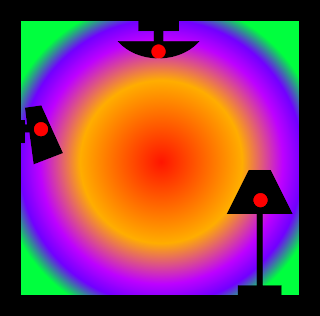I thought this would be a simple, inexpensive purchase so I looked online for an existing solution. They have all kinds of plug-in USB adapters for wall outlets so surely they must make a version that screws into a light bulb socket. Something that I could just replace the bulb with, then plug my Arduino with NeoPixels into the shiny new USB port and have instant power for my project. Surely I'm not the only one who wants to make a light show for an old lamp.
 |
| You can easily provide 5v USB power for your Arduino project from a screw in lamp or light socket. |
But I could not find a version like I wanted. They do have big, bulky awkward looking versions, but not the simple, small ones like I was envisioning. They also have pre-made remote control adapters that turn the light bulbs on and off with WiFi, Bluetooth and even LORA. Then there are the popular HUE and other RGB light bulb systems.
But I wanted to make my own custom light show, so none of these commercial solutions worked for me. All I wanted was to change the screw-in socket to a USB power supply.
Luckily, I still have lots of electrical adapters from my days of being a budget-sensitive-photographer.
I'm talking way back before LED light panels really existed, when studio lights were super expensive (like thousands, not hundreds of dollars) and beginner photographers made their own lighting systems by cobbling together clusters of incandescent bulbs and foam-core reflectors. I had not used those adapters in a couple of decades, but I knew exactly where they were.
And I had an idea.
Use one of my ancient "screw-in-socket to pronged-outlet adapters" and then just plug one of the dozens of tiny USB outlet adapters I own into the first adapter. It is a horrible, clunky kludge and it really appealed to my sense of nostalgic, just-make-it-work-any-way-you-can, DIY mind set.
It worked great, it was totally free, and it made me happy using 25 year old technology again.
Now I'm thinking of retrofitting some of my ceiling fixtures with larger LED arrays. Or maybe turn every single fixture into a giant array of RGB goodness. This might require more thought to network and properly power all those LEDs, but the principle is the same.
I'm sure once I post this the Google machine will start showing me the perfect pre-made commercial version, but I thought I would share in case there was someone else wanting to do the same thing who had never had to use such old-school methods.
SHOPPING LIST
Here are some links to the parts I used. (affiliate links)
Screw-in socket to outlet adapterScrew-in socket to outlet adapter to keep existing bulb
Commercial lamp socket to USB adapter
Outlet to USB power adapter
Short USB Cable
USB angle adapters
Arduino with Wifi
Arduino with Bluetooth


No comments:
Post a Comment